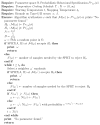Parameter discovery in stochastic biological models using simulated annealing and statistical model checking
- PMID: 24989866
- PMCID: PMC4438994
- DOI: 10.1504/IJBRA.2014.062998
Parameter discovery in stochastic biological models using simulated annealing and statistical model checking
Abstract
Stochastic models are increasingly used to study the behaviour of biochemical systems. While the structure of such models is often readily available from first principles, unknown quantitative features of the model are incorporated into the model as parameters. Algorithmic discovery of parameter values from experimentally observed facts remains a challenge for the computational systems biology community. We present a new parameter discovery algorithm that uses simulated annealing, sequential hypothesis testing, and statistical model checking to learn the parameters in a stochastic model. We apply our technique to a model of glucose and insulin metabolism used for in-silico validation of artificial pancreata and demonstrate its effectiveness by developing parallel CUDA-based implementation for parameter synthesis in this model.
Keywords: CPS; CUDA; SPRT; artificial pancreata; behavioural specifications; biochemical systems; bioinformatics; biomedical devices; computational systems biology; cyber–physical systems; glucose–insulin model; machine learning; parameter discovery; parameter synthesis; probabilistic verification; simulated annealing; statistical hypothesis testing; statistical model checking; stochastic modelling; temporal logic.
Figures










Similar articles
-
Automated parameter estimation for biological models using Bayesian statistical model checking.BMC Bioinformatics. 2015;16 Suppl 17(Suppl 17):S8. doi: 10.1186/1471-2105-16-S17-S8. Epub 2015 Dec 7. BMC Bioinformatics. 2015. PMID: 26679759 Free PMC article.
-
The Infobiotics Workbench: an integrated in silico modelling platform for Systems and Synthetic Biology.Bioinformatics. 2011 Dec 1;27(23):3323-4. doi: 10.1093/bioinformatics/btr571. Epub 2011 Oct 12. Bioinformatics. 2011. PMID: 21994219 Free PMC article.
-
Population stochastic modelling (PSM)--an R package for mixed-effects models based on stochastic differential equations.Comput Methods Programs Biomed. 2009 Jun;94(3):279-89. doi: 10.1016/j.cmpb.2009.02.001. Epub 2009 Mar 5. Comput Methods Programs Biomed. 2009. PMID: 19268387
-
Stochastic modelling for quantitative description of heterogeneous biological systems.Nat Rev Genet. 2009 Feb;10(2):122-33. doi: 10.1038/nrg2509. Nat Rev Genet. 2009. PMID: 19139763 Review.
-
Machine learning in bioinformatics.Brief Bioinform. 2006 Mar;7(1):86-112. doi: 10.1093/bib/bbk007. Brief Bioinform. 2006. PMID: 16761367 Review.
Cited by
-
Automated parameter estimation for biological models using Bayesian statistical model checking.BMC Bioinformatics. 2015;16 Suppl 17(Suppl 17):S8. doi: 10.1186/1471-2105-16-S17-S8. Epub 2015 Dec 7. BMC Bioinformatics. 2015. PMID: 26679759 Free PMC article.
References
-
- Amin MS, Bhattacharjee A, Finley RL, Jr, Jamil H. A stochastic approach to candidate disease gene subnetwork extraction. Proceedings of the 25th ACM Symposium on Applied Computing; 22–26 March; Sierre, Switzerland. 2010. pp. 1534–1538.
-
- André É, Soulat R. The Inverse Method. ISTE Ltd and John Wiley & Sons Inc; London and Hoboken, NJ: 2013.
-
- Astrom KJ. Introduction to Stochastic Control Theory. Dover Publications; Mineola, NY: 2006.
-
- Bertsimas D, Tsitsiklis J. Simulated annealing. Statistical Science. 1993;8(1):10–15.
MeSH terms
Substances
Grants and funding
LinkOut - more resources
Full Text Sources
Other Literature Sources
Medical

